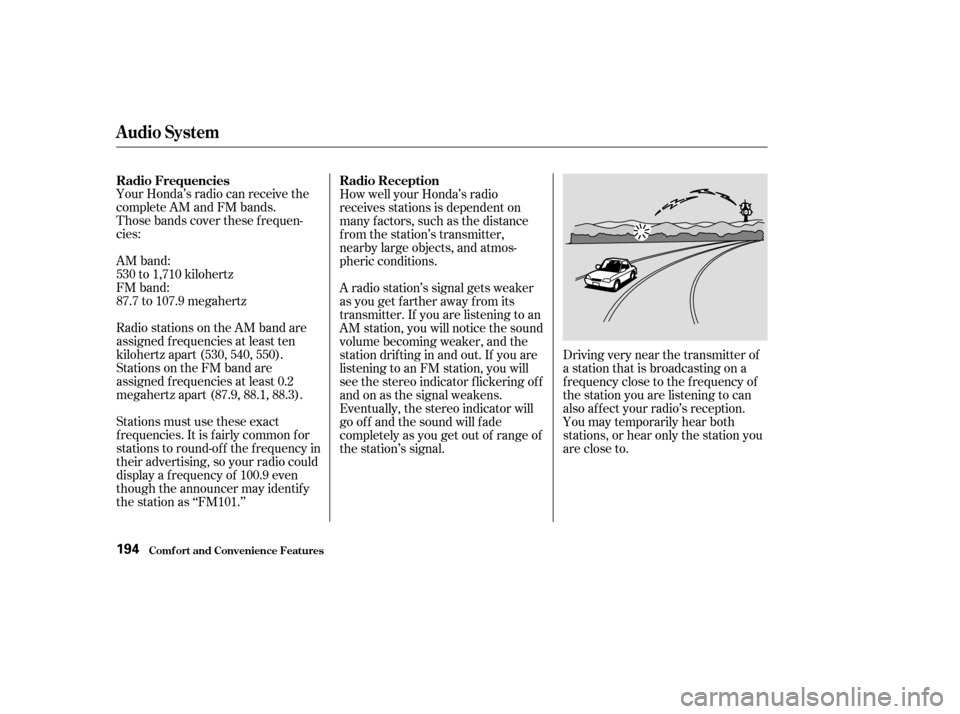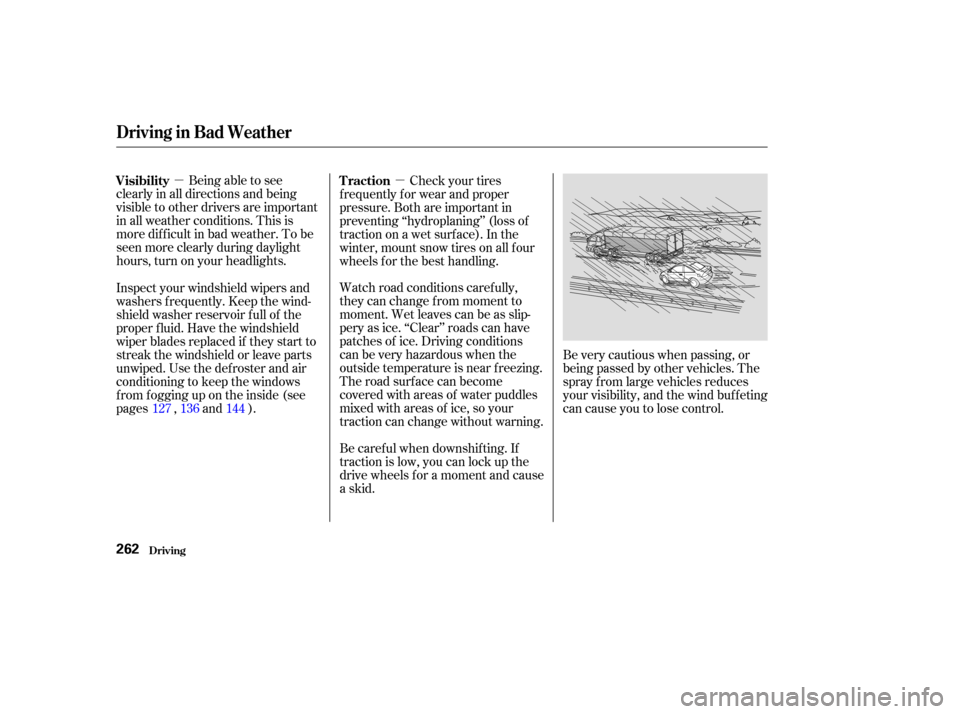Page 134 of 429
To put the Automatic Climate
Control in f ully-automatic mode,
press the AUTO button, then set the
desired temperature by turning the
driver’s temperature control dial.
You will see AUTO in the system’s
display.
The system automatically selects the
proper mix of conditioned and/or
heated air that will, as quickly as
possible, raise or lower the interior
temperature f rom its current level to
the set temperature.
CONT INUED
Climat e Cont rol Syst em
Comf ort and Convenience Feat ures
Fully-automatic Operation
Without Navigation System
131
RECIRCULATION BUTTON
OFF BUTTON PASSENGER’S SIDE
TEMPERATURE
CONTROL DIAL
FAN CONTROL
BUTTONS
DRIVER’S SIDE
TEMPERATURE
CONTROL DIAL
AUTO BUTTON TEMPERATURE DISPLAY
Page 135 of 429

You can manually select various
f unctions of the Climate Control
system when it is in f ully automatic
mode. All other f eatures remain auto-
matically controlled. Making any
manual selection causes the word
AUTO in the display to go out.
Press the A/C button to turn the air
conditioningonandoff.Youwillsee
A/C ON or A/C OFF in the display.This button controls the source of air
going into the system. When the
indicator in this button is lit, air f rom
the car’s interior is sent through the
system again (Recirculation mode).
When the indicator is off, air is
brought in f rom outside the car
(Fresh Air mode).
You can, f or example, manually put
the system in recirculation mode
when driving through an area of
smoke or f umes.
When you turn the A/C of f , the sys-
tem cannot regulate the inside tem-
perature if you set the dial below the
outside temperature. With the A/C
of f , use the temperature control dial
to adjust the temperature of the air
flow to a comfortable setting.
When you set the temperature to its
lower limit ‘‘ ’’ or its upper
limit ‘‘ ’’, the system runs at
f ull cooling or heating only. It does
not regulate the interior temperature.
In cold weather, the f an will not
come on automatically until the car
has been driven f or a short time and
the heater starts to develop warm air.
Pressing the OFF button shuts the
climate control system completely
off. No air flow can cause the
windows to fog up. It is
recommended that you keep the f an
on at all times so stale air and
moisture do not build up in the
interior and cause f ogging.
Climat e Cont rol Syst em
Comf ort and Convenience Feat ures
Semi-automatic Operation
A ir Condit ioning (A /C) But t on
Recirculat ion But t on
132
Page 136 of 429
�Û�Ý
CONT INUED
You can manually select the f an
speed by pressing the f an control
buttons: to increase the f an’s
speed, or to decrease the f an’s
speed.
Press the DUAL button to select the
dual temperature control mode (see
page ).
Use the MODE button to select the
vents the air flows from. Some air
will f low f rom the dashboard corner
vents in all modes; you can turn it of f
with the dial below each vent. Each
time you press the MODE button,
the display shows the mode selected.
Press the button four times to see all
the modes. 137
Climat e Cont rol Syst em
Comf ort and Convenience Feat ures
Fan Control Buttons
Mode Button
Dual Button
133
FAN CONTROL BUTTONS
RECIRCULATION BUTTON
DUAL BUTTON MODE BUTTON
AIR CONDITIONING
BUTTON
Page 141 of 429
�Û
�Ý
To put the Automatic Climate
Control in f ully-automatic mode,
press the AUTO button. The
indicator in the button will light.
Then set the desired temperature by
pressing the temperature buttons:
to raise the temperature above the
displayed value, or to lower the
temperature.
The system automatically selects the
proper mix of conditioned and/or
heated air that will, as quickly as
possible, raise or lower the interior
temperature f rom its current level to
the set temperature.
With Navigation System
Climat e Cont rol Syst em
Comf ort and Convenience Feat ures
Fully-automatic Operation
138
AUTO BUTTON OFF BUTTON
RECIRCULATION
BUTTON
TEMPERATURE DISPLAY
DRIVER’S SIDE
TEMPERATURE
CONTROL BUTTONS PASSENGER’S SIDE
TEMPERATURE
CONTROL BUTTONS
Page 143 of 429
Touching ‘‘ON’’ or ‘‘OFF’’ in the
display turns the air conditioning on
andoff.YouwillseeA/CONorA/C
OFF in the display.
When you turn the A/C of f , the sys-
tem cannot regulate the inside tem-
perature if you set it below the out-
side temperature. With the A/C off,
use the temperature control buttons
to adjust the temperature of the air
flow to a comfortable setting.
Climat e Cont rol Syst em
Comf ort and Convenience Feat ures
A ir Condit ioning (A /C) Icons
140
PASSENGER’S SIDE
TEMPERATURE DISPLAY
DRIVER’S SIDE
TEMPERATURE DISPLAY
AIR CONDITIONING
(A/C) ICONS
MODE ICONS
FAN CONTROL
ICONS A/C BUTTON
Page 197 of 429

Your Honda’s radio can receive the
complete AM and FM bands.
Those bands cover these f requen-
cies:
AM band:
530 to 1,710 kilohertz
FM band:
87.7 to 107.9 megahertz
Radio stations on the AM band are
assigned f requencies at least ten
kilohertz apart (530, 540, 550).
Stations on the FM band are
assigned f requencies at least 0.2
megahertz apart (87.9, 88.1, 88.3).
Stations must use these exact
f requencies. It is f airly common f or
stations to round-of f the f requency in
their advertising, so your radio could
display a f requency of 100.9 even
though the announcer may identif y
the station as ‘‘FM101.’’How well your Honda’s radio
receives stations is dependent on
many f actors, such as the distance
from the station’s transmitter,
nearby large objects, and atmos-
pheric conditions.
A radio station’s signal gets weaker
as you get f arther away f rom its
transmitter. If you are listening to an
AM station, you will notice the sound
volume becoming weaker, and the
stationdriftinginandout.If youare
listening to an FM station, you will
see the stereo indicator f lickering of f
and on as the signal weakens.
Eventually, the stereo indicator will
go of f and the sound will f ade
completely as you get out of range of
the station’s signal.
Driving very near the transmitter of
a station that is broadcasting on a
f requency close to the f requency of
the station you are listening to can
also af f ect your radio’s reception.
You may temporarily hear both
stations,orhearonlythestationyou
are close to.
Radio Frequencies
Radio Reception
Audio System
Comf ort and Convenience Feat ures194
Page 234 of 429

A cold engine uses more f uel than a
warm engine. It is not necessary to
‘‘warm-up’’ a cold engine by letting it
idle f or a long time. You can drive
away in about a minute, no matter
how cold it is outside. The engine
will warm up f aster, and you get
better f uel economy. To cut down on
the number of ‘‘cold starts,’’ try to
combine several short trips into one.
You can improve f uel economy by
driving moderately. Rapid acceler-
ation, abrupt cornering, and hard
braking use more f uel.
Always drive in the highest gear that
allows the engine to run and acceler-
ate smoothly.
The air conditioning puts an extra
load on the engine which makes it
usemorefuel.Turnoff theA/Cto
cut down on air conditioning use.
Use the f low-through ventilation
when the outside air temperature is
moderate.
The condition of your car and your
driving habits are the two most
important things that affect the fuel
mileage you get.
Always maintain your car according
to the maintenance schedule. This
will keep it in top operating condition.
Depending on traf f ic conditions, try
to maintain a constant speed. Every
time you slow down and speed up,
your car uses extra f uel. Use the
cruise control, when appropriate, to
increase f uel economy.
An important part of that mainte-
nance is the
(see page ). For
example, an underinf lated tire
causes more ‘‘rolling resistance,’’
which uses f uel. It also wears out
f aster, so check the tire pressure at
least monthly.
In winter, the build-up of snow on
your car’s underside adds weight and
rolling resistance. Frequent cleaning
helps your f uel mileage and reduces
thechanceof corrosion. 291 Driving Habits
Owner Maintenance
Checks Car Condition
Fuel Economy
Bef ore Driving231
Page 265 of 429

�µ�µBeing able to see
clearly in all directions and being
visible to other drivers are important
in all weather conditions. This is
more dif f icult in bad weather. To be
seen more clearly during daylight
hours, turn on your headlights. Check your tires
f requently f or wear and proper
pressure. Both are important in
preventing ‘‘hydroplaning’’ (loss of
traction on a wet surface). In the
winter, mount snow tires on all f our
wheels f or the best handling.
Watch road conditions caref ully,
they can change f rom moment to
moment. Wet leaves can be as slip-
pery as ice. ‘‘Clear’’ roads can have
patches of ice. Driving conditions
can be very hazardous when the
outside temperature is near f reezing.
The road surf ace can become
covered with areas of water puddles
mixed with areas of ice, so your
traction can change without warning.
Be caref ul when downshif ting. If
traction is low, you can lock up the
drive wheels f or a moment and cause
askid. Be very cautious when passing, or
beingpassedbyothervehicles.The
spray f rom large vehicles reduces
your visibility, and the wind buf f eting
can cause you to lose control.
Inspect your windshield wipers and
washers f requently. Keep the wind-
shield washer reservoir f ull of the
proper f luid. Have the windshield
wiper blades replaced if they start to
streak the windshield or leave parts
unwiped. Use the def roster and air
conditioning to keep the windows
f rom f ogging up on the inside (see
pages , and ).
136 144
127
Visibility
Traction
Driving
Driving in Bad Weather
262